Not quite trees and not quite flowers—shrubs. Defined as "a woody plant which is smaller than a tree and has several main stems arising at or near the ground" per Oxford Languages, Central Oregon has its fair share of shrubs. From our forests to our sagebrush-steppe, there are tall shrubs and short shrubs, fragrant and odorless, blooming pink, yellow, and white. Let's look at some of the common shrubs in our high desert home.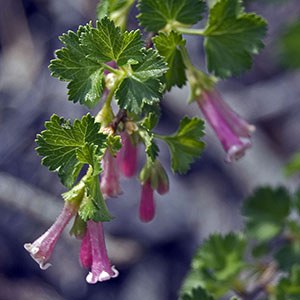
Other common names: none
Wax currant grows in mountain forests, sagebrush, and on the dry edges of forests. It grows 2-6 feet tall. Leaves are gray-green, shiny, and finely toothed. In the spring and early summer, flowers hang in clusters from the tips of branches. Flowers are white to pale pink and shaped like long tubes. Wax currant has an aromatic, "spicy" smell. It is enjoyed by birds (particularly hummingbirds), butterflies, and bees. It is a host plant for hoary comma and tailed copper butterflies.
Bloom time: Spring - early summer
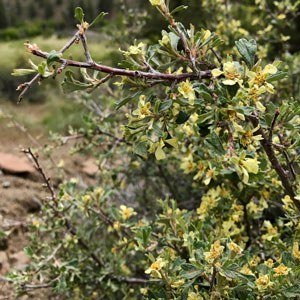
Other common names: Antelope bitterbrush, Antelope-brush, buckbrush, quinine brush
Bitterbrush is very common in our east-side forests. This shrub has rigid stems and grows to be 3-10 feet tall. Flowers are small with 5 yellowish petals. Leaves are thick and three-lobed with edges that roll under. Bitterbrush is an important food for wildlife that browse--deer, elk, and pronghorn, as well as birds and small animals who utilize the seeds. The shrub is well-adapted to our area with water-loss resistant leaves and long taproots.
Bloom time: Late spring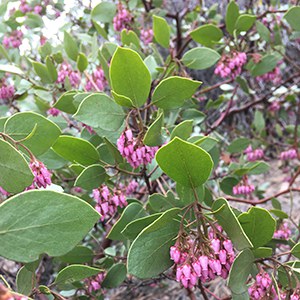
Other common names: Greenleaf manzanita
A common sight in our ponderosa pine forests, green manzanita is easily recognizable by its reddish-brown branching stems. Green manzanita grows 3-7 feet tall. It has evergreen leaves that are 1-2 1/2 inches long and oval with rounded tips. Flowers are small, pink, and bell-shaped. They grow in dense clusters at the tips of stems. With spreading roots, you'll often see dense groupings of green manzanita. Birds (including hummingbirds), insects, and butterflies are all attracted to this shrub. Central Oregon also has pinemat manzanita, which grows around 1 foot tall and has white flowers in smaller clusters.
Bloom time: Late spring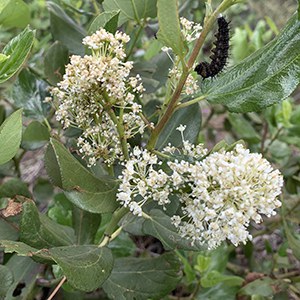
Other common names: Tobacco bush, varnish-leaf, mountain balm, buckbrush, red root
A VERY fragrant shrub (your nose will alert you to its presence!). Snowbrush has stout stems that are many branched, growing 3-11 feet tall. It has 1-3 inch shiny evergreen leaves that are widely oval and finely toothed. Flowers are white in thick rounded clusters near the tops of stems. Snowbrush grows in open woods and especially in burned areas. As it forms groups of individuals, their branches tangle together to form nearly impenetrable barriers. Their seeds can remain buried for over 200 years before sprouting. Snowbrush is beneficial to bees and butterflies, and is a host plant for California tortoiseshells, pale tiger swallowtails, and spring azures, among others.
Bloom time: Late spring - early summer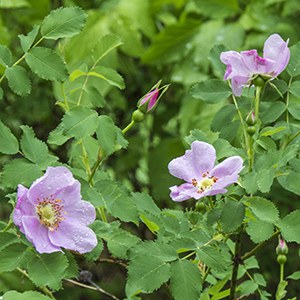
Other common names: Pearhip rose, interior rose
A very common shrub that can form dense thickets. It is found in meadows and along streams. Woods' rose grows 3-6 feet tall. Leaves are medium green and have 5-9 leaflets that are wide in the middle, round at the tips, and toothed. Flowers are light pink to a deep rose color with five petals that are 3/4-1 inch long. After the flowers bloom, the rosehips are orange-red, pear-shaped, and about 1/3 inch long. Birds really enjoy eating the rosehips. Woods' rose has a number of varieties that occur throughout the American West.
Bloom time: All summer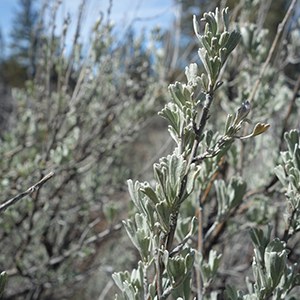
Other common names: Common sagebrush, Great Basin sagebrush
No Central Oregon shrub guide is complete without big sagebrush. This shrub grows 3-6 1/2 feet tall with a thick, woody trunk. Leaves are gray-green, evergreen, and soft. They have 3 lobes on a wide tip. Big sagebrush is aromatic, especially after a rainfall. Flowers are quite small and yellow with hairy stems. Big sagebrush is browsed by mule deer, Rocky Mountain elk, and antelope. It also provides nesting areas for songbirds. You can find big sagebrush throughout our sagebrush-steppe environment.
Bloom time: Late summer - fall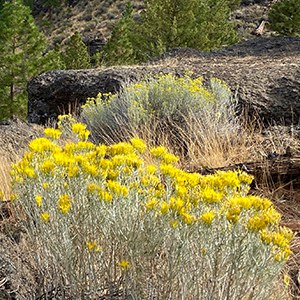
Other common names: Rubber rabbitbrush, chamisa
Very common in Central Oregon! Rabbitbrush can grow 5-7 feet tall. It has flower heads that consist of small, yellow, tubular flowers arranged in dense clusters. Rabbitbrush's presence might help reduce the severity of weed invasions, using its deep roots and large amounts of leaf litter to outcompete invasive weeds. It also provides cover for small animals and birds, as well as being a food source for mule deer and pronghorn. Gray rabbitbrush can be found in open lands and in east-side forests.
Bloom time: Late summer - fall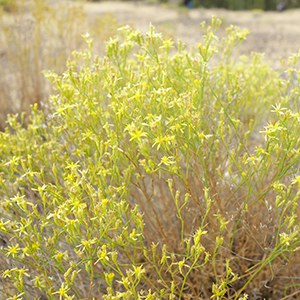
Other common names: Match brush, matchweed, broomweed, stinkweed, turpentine weed
Out in the dry areas of Crook and Jefferson counties, snakeweed is a small shrub that grows 8-18 inches tall. Stems sprawl out and up, making it bushy. Leaves are yellow-green, quite narrow, and alternate on stems. They usually produce a single or small cluster of yellow flowers. Flowers are rayed with 2-8 petals. Snakeweed was occasionally used as a treatment for snakebite, hence its name. Historically, it could also be used as a broom when bundled together.
Bloom time: Fall
Learn more:
Sources:
- Wildflowers of the Pacific Northwest by Mark Turner and Phyllis Gustafson
- California Native Plant Society
- Lady Bird Johnson Wildflower Center


